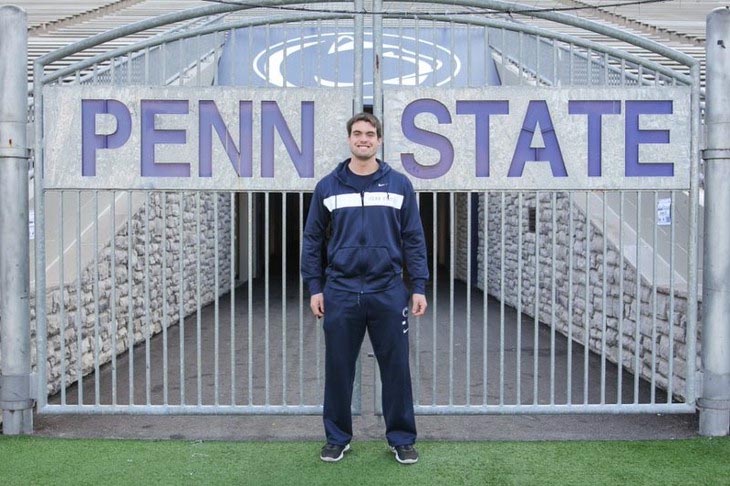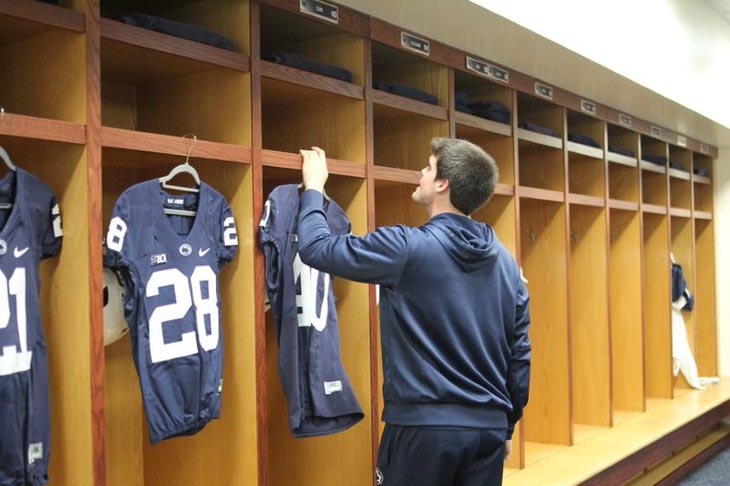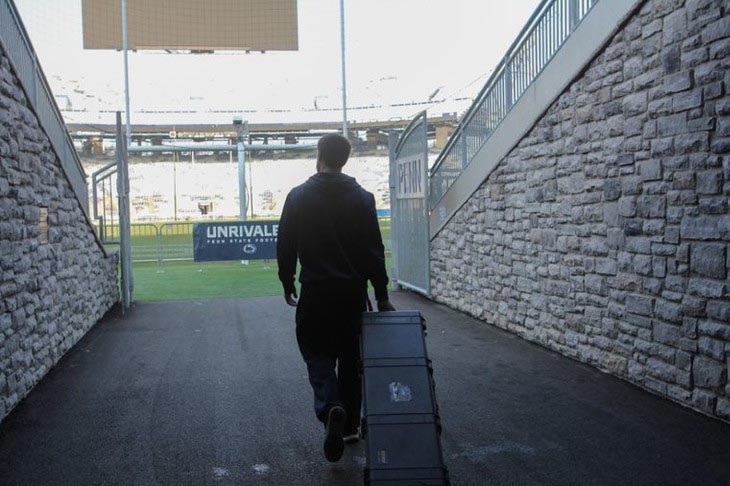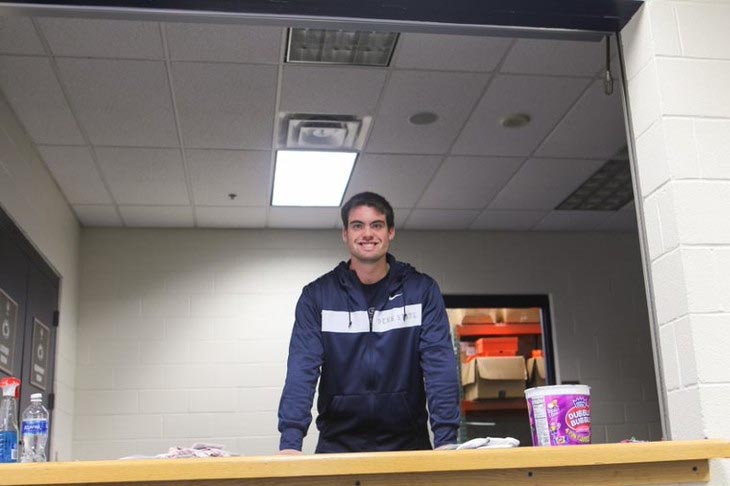
Sam Hammers knew that he wanted to earn his engineering degree from Penn State and jumped on the opportunity. He will be graduating in May 2020. IMAGE: MIRANDA BUCKHEIT
Student merges his love of football and engineering
1/27/2020
By Miranda Buckheit
UNIVERSITY PARK, Pa. — Penn State fans travel far and wide to attend the University’s football games each fall semester, but few get to see the behind-the-scenes coordination that it takes to get the players ready for game day.
For Sam Hammers, a senior in the Harold and Inge Marcus Department of Industrial and Manufacturing Engineering (IME), it has been a dream come true to work as a student equipment manager for the Penn State football team and see how his education in distribution process improvement is applied in the real world.
Hammers has loved football his whole life. He was a right guard for the the West Allegheny High School football team in Imperial, Pennsylvania, and had offers to play collegiately at other schools, but he had his eyes on Penn State.
“When I had the opportunity to come to Penn State and work for the team, I took it as fast as possible because I wanted to get my engineering degree from here,” Hammers said.
Hammers explained that he chose industrial engineering, in particular, because of the department’s legacy. He also has found the major to be a “jack of all trades,” as it is widely applicable across numerous disciplines.
Sarah Root, associate teaching professor and undergraduate adviser, has advised Hammers in the past and taught his service systems engineering (IE 460) class in the fall 2019 semester.
"It is always fantastic to see students who are engaged in class applying their skills to real-world problems,” Root said. “It’s especially cool when they benefit Penn Staters, both present and future.”
Equipment management … and time management
For Hammers, it was a delicate balance among his education, job and social life. He spent 40 to 50 hours weekly working for the football team, on top of his full course load.
“It was all about prioritizing what needed to be done first among my assignments, like homework and studying,” Hammers said.
Hammers began working with the football team during his first year at Penn State, and he worked his way up to a student equipment manager.
Initially, Hammers primarily focused on preparing and restocking football clothing, gear and other supplies. When he started, the equipment room was typically back in order by Wednesday or Thursday after the prior week’s game.
Hammers worked with his two supervisors, Jay Takach, assistant athletics director for equipment services, and Stewart Carter, assistant equipment manager, to help improve the football team’s distribution center by optimizing the way it handles stock.
“Sam brings unique perspective as an industrial engineering major to our operation and how we approach certain tasks,” Takach said. “He has made a few suggestions, which have allowed us to streamline some of our processes.”
“I thought I would be doing every little task that people told me, but I realized that I could take my industrial engineering skills and help make things better,” Hammers said. “We can not only get things put away faster, but we are quicker at getting items pulled out.”
In addition to his equipment room responsibilities, Hammers began to help on the field during his sophomore year when he was assigned to the running backs.
Before the games, he managed the sideline set up and helped identify where equipment needed to be set up to be as efficient as possible. During the game, he held up boards and play cards to help direct players. When the game was over, he began to pack everything away once again.
“If it was an evening game, like a 7:30 p.m. kickoff, I tried to be at the stadium around 4 p.m.,” Hammers said. “After the game, we had to pick it up, make sure laundry got done and we began to put items away. I usually left around 2:30 a.m. after evening games. When people would say that they wanted to have a night game, I wanted a noon game!”
Without even knowing
In addition to his work with the football team, Hammers interned for the summer before his junior year with Rogers Athletic, a premier football equipment manufacturer and supplier. Based in Farwell, Michigan, Rogers Athletic was founded in 1968 to supply youth, high school, college and professional football teams with high-grade equipment like sleds and dummies to improve strength training and promote proper technique.
For Hammers, the internship was an example of being in the right place at the right time.
“I didn’t know it at the time, but I was showing a man where to park, and he was the brother of the Rogers Athletic chief executive officer,” Hammers said. “We ended up talking about my experience, and he was excited to talk about internships once he found out that I was a Penn State engineer.”
During his time with the company, Hammers worked on various projects, such as assisting the company on the shipping design of its 10-foot by 20-foot mobility chute.
A mobility chute, a standard piece of practice equipment, allows players to practice staying low for longer distances. By utilizing four metal poles and height adjusters, a trampoline-like mesh is suspended in the air to make players move beneath.
“In football, the lower person always wins,” Hammers said. “To be able to practice at a lower height strengthens the legs and improves stability when taking low hits. You have to move under the chute, but the height of it doesn’t allow you to fully stand up.”
The company encountered shipping problems, as the 20-foot poles that created the length of the chute made the shipping fee spike by over $100. Hammers designed new poles with a split in the center that didn’t compromise the integrity of the equipment. The company now sends an additional two packages to deliver six poles instead of four, but the length falls within standard shipping rates.
“They would ask me how I would use different equipment based on my football experience,” Hammers said. “When it came to the chute project, I was using industrial engineering principles without even realizing it — I made it more cost efficient.”
What does the future hold?
After his last season with the team, Hammers is still trying to find ways to work with his managers to improve the design of the equipment room.
“It’s funny because the other student workers come up to me and ask me why I am helping with improvements because I am a senior,” Hammers said. “Sure, I’m leaving, but wouldn’t it be nice for them to have a better way of doing things next year? I like doing these kinds of things in my spare time.”
During the December break, Hammers traveled with the team for the 2019 Cotton Bowl Classic at AT&T Stadium in Arlington, Texas. Hammers explained that he was able to participate in multiple Cotton Bowl sponsored events throughout the week, but his favorite part of the experience was game day.
“It was such a surreal feeling from the early morning setup to running through the confetti,” Hammers said. “This bowl meant everything to me. It was my last hurrah with the football team. To be able to walk away from my position with a victory is just the cherry on top.”
After his upcoming graduation in May 2020, Hammers plans to take the Fundamentals of Engineering exam — the first step in becoming a licensed professional engineer. His ultimate goal is to work within an industrial engineering-related position and earn a professional engineering license.
While he’s looking forward to the future, once he walks across the stage, Hammers knows that he will miss being a part of the team.
“The students on the equipment team know me as the engineer and they are always asking me if they have good engineering ideas,” Hammers said. “Football feels like family.”
The student spotlight series by the Penn State Harold and Inge Marcus Department of Industrial and Manufacturing Engineering (IME) aims to highlight innovators, makers and those that personify engineering excellence in their academic studies. The department currently has 90 doctoral students, 59 master’s students and 436 undergraduate students. In addition, the department hosts 31 full-time and courtesy faculty members. Established in 1908, the department is home to the first industrial engineering program in the world and has made a name for itself in the engineering industry through its storied tradition of unparalleled excellence and innovation in research, education and outreach. To learn more about IME and how you can get involved, visit ime.psu.edu.




 Hammers helps with the equipment distribution, game day set-up and practices. IMAGE: MIRANDA BUCKHEIT
Hammers helps with the equipment distribution, game day set-up and practices. IMAGE: MIRANDA BUCKHEIT
